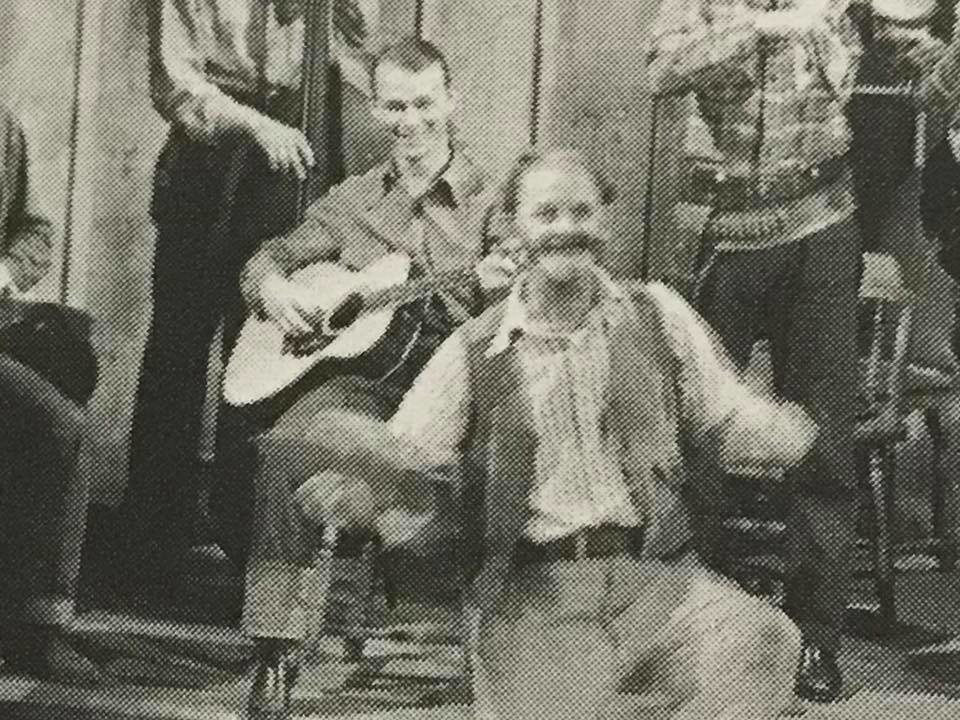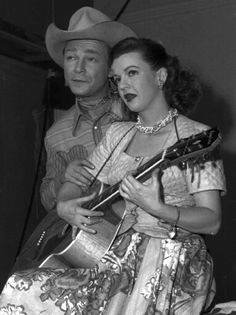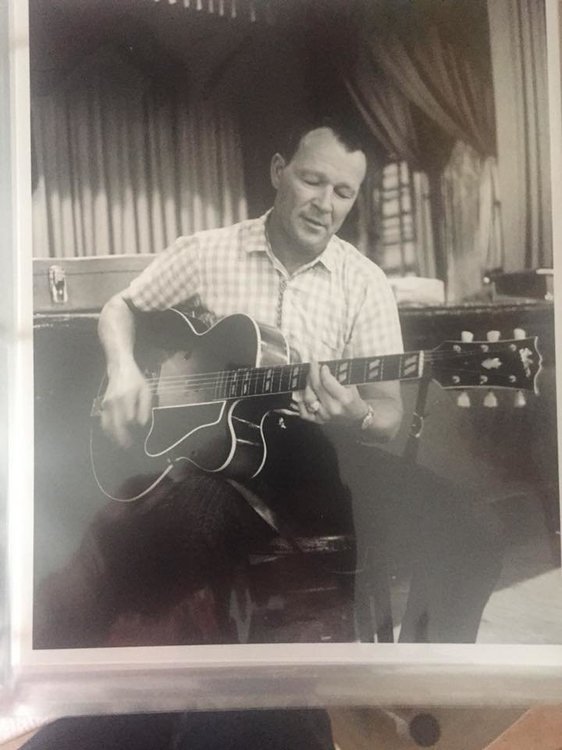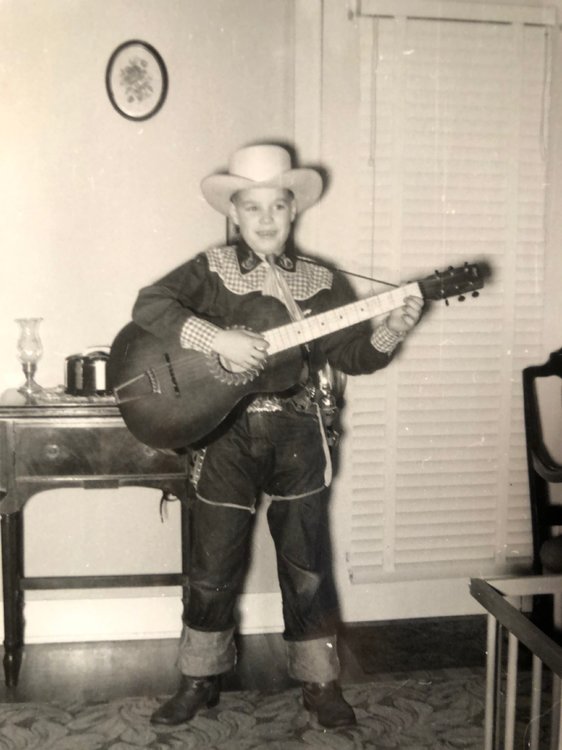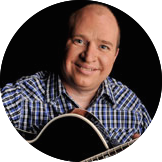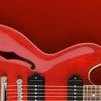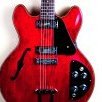-
Posts
83 -
Joined
-
Last visited
-
Days Won
4
Content Type
Profiles
Forums
Gallery
Events
Articles
Blogs
Downloads
Everything posted by Brad Baugh
-
He shows up with the guitar everywhere. Not sure which movie this is from ... he is probably with the Sons of the Pioneers and backing up Gene Autry or Charles Starrett.
-
GUITAR AMPLIFIER ENCYCLOPEDIA BRIAN TARQUIN ALLWORTH PRESS NEW YORK. NY ISBN 978-1-62153-499-0 2016 130 PAGES AMAZON $ 9 - $20 Hi all, after looking at the history of the electric guitar I figured I should also look at the amplifiers that they are required to use to present their sound. The book Guitar Amplifier Encyclopedia reviews the history of the amplifier. Brian Tarquin does an excellent job in providing colored pictures of all the great amps along with his extensive research and writing. Many of the amps presented I had never heard of before reading this book. Manufactures from all over the world are represented and what they did to amplify their products (pun intended). The following is a list of the book chapters along with the topics covered in the chapter. Chapter 1: Amplifier History The Beginning Early Amp Designers The Vintage Collector Les Paul Gibson Chapter 2: Fender, King of Amps Innovation Guitar & Amps The Sixties CBS Era A Change is Coming” Chapter 3: British Invasion Vox AC30 Star Power Jim Marshall Early Days JTM 45 Iconic Guitarists The Plexi JCM Series New Era Conclusion Chapter 4: Dr. Z: Rise of a Boutique Builder In the Beginning Fender’s Benchmark Tube Technology Analog vs. Digital Innovative Amps Inner Electronics of the Beast Proof’s in the Pudding UL Approved The Future Chapter 5: The Players Jeff Beck Zakk Wylde Hal Lindes Larry Carlton Gary Hoey Lelie West Randy Coven Chapter 6: Amp Designers Ampeg Carr Carvin CeriaTone Danelectro/Silvertone Divided by 13 Egnater ENGL Epiphone Fargen Harmony Ibanez Industrial Jet City Jim Kelly Kustom Lafayette Lectrolab Line 6 Magnatone Matchless MESA/Boogie Orange Pignose Premier Paul Reed Smith Quilter Roland Selmer Seymour Duncan Soldano Sovtek Supro Tone King Traynor Two-Rock Watkins Attenuators Bibliography O.K. if you can’t find your amp in that list then you have one that is home made or a designer. The author covers the history of each of the companies. Many of the company owners worked for and developed amps for their competitors and then went out on their own. Others developed an amp in their home shop and got individual requests to build an amp for a friend or a performer. The requests snowballed to the point until the individual had to create his/her own company. As you see above, Brian listed several guitar players (along with the amps they use or used). I went on "You Tube" and downloaded two performances (trying to select 1 live presentation and 1 in the recording studio) for each of the players named. It made it more interesting listening to the sounds they created as it related to a designated amp. The author was good about presenting what equipment was used by what artist. I think you will enjoy this book, particularly if you are a solid body guitar person. This is a nice coffee table book and it complements the other coffee table book I recommended earlier …Total Guitar by Terry Burrows. Well, I have a bunch of things to get completed in the next couple weeks because I am heading back to school. All the reading I have been doing has made me excited about getting back in the classroom … I have signed up for Music Theory I and Classical Guitar … I’ll keep you posted on how it goes.
-
Nice job ... thanks for sharing gives others something to look at for their future.
-
-
Hi Steve, I just ran into something that could be very beneficial. Short of the old arguments between tube vs solid state amps I really know nothing about them. I am reviewing a book on amps for next month and found that there are more amps out there than I ever dreamed of ... I am not looking at brands necessarily, but more of how an amp is put together, what you should look at for a practice amp, small group amp, recording amp, and professional stage designs. There are thousands of switches and button to push in or pull out and I have no idea what each thing does. One place says the old Fender reverbs and the new pedals are not really compatible and then you add to that all the "guitar language" for squeals, squacks, and feed-back it kind of leaves a person out at the far end as to what should I really look for when buying an amp. A good DVD about the language alone would be great. Just an idea. Thanks
-
Hi All, The Art and Times of the Guitar: An Illustrated History of Guitars and Guitarists FredericV. Grunfeld Collier Books New York 1969 (There are several other editions) CN 69-10465 AMAZON … $6.00 - $130.00 I have the original paper back edition from 1969 and that is what I will use for this review. With some of the unique pictures found in the book I kind of wished I would have gone for a newer hardback edition. This book should be REQUIRED READING for anyone majoring in guitar at the college level. For the rest of you if you like to haunt old museums and look at old old paintings and pieces of different types of stringed instruments this book is for you. It not only looks at the development of the guitar but also the love hate relationships with the instrument throughout the past. For instance following a military battle between the Spanish and Portuguese the defeated army evacuated the field of confrontation leaving behind over 11,000 guitars … at least that was what was reported. At another time in history all the guitars were confiscated by a government and some of the players lost their heads … wonder what happened if the average musician played a bad note (Ah yes, another reason to practice. Yes, this is the book that compares man and ape on their ability to play the guitar.). More than one story talks about the “love” of the guitar and its actual design following that of the female figure (That ought to get a couple of you to read the book.). Just as the title states this is a highly illustrated book with a lot of interesting history about the guitar based on art. The chapters in the book consist of: A Twang for All Seasons When Is a Guitar? Guitarra and Vihuela La Guitar Royalle The Age of Figaro Guitaromanie Wine Cups of Daybreak The Guitar in America Six Maids Dancing Isn’t it interesting how if you don’t read the chapter you don’t understand the title. I wasn’t sure what kind of book I was getting when I picked this book out of my collection. It is truly the history of the guitar starting with its conception i.e. a turtle shell with strings strung across it. Add this to the book I reviewed on the history of the electric guitar (Play it Loud) and you should know most of the things hidden under the bed about the instrument. Not only is the evolution of the structural design of the instrument presented but the story progresses with the development of the different number of strings on the instrument, creation of the frets, and various instructional methods. The pictures in the book are done by Master Artists as well as sketchers and show the guitar in many different concepts. Along with the music of different time periods the use of the guitar for romancing and dancing are discussed. Interestingly the instrument was played by both sexes and in some cases the ladies out did the men. At other times the guitar was described as not being “lady-like” and the polished woman should learn a different instrument. Multiple paragraphs describe the “feelings” of various individuals (especially song writers and composers) and their countries towards the guitar. The first part of the book concentrates on Spain, England, Italy, Germany, and the Arab conquers and how the guitar was played everywhere. Side note …. interestingly guitars were hung in some barbershops and patrons could play them while waiting to be shaved. The author then leaves Europe and skips to America. Here he talks about the 3 basic guitar schools or philosophies that developed within the country … European guitar (Chiefly English from the Revolutionary times), the Blues of the deep south, and the Spanish Latin-American style of the southwest. As the country grew everyone had a guitar and many guitars traveled west in covered wagons, on the back of horses or oxen, or in bags slung over the shoulder of those who walked. The enrichment and love for the guitar continued and as the nations population grew the guitar made many people wealthy. The next section of the book presents a brief history of the blues and jazz scene in early 20th Century, followed by the more lucrative end of the guitar business. Len Slye bought a $3 guitar, learned to play it and then became Roy Rogers King of the Cowboys. According to the author Roy said “Music makes our family rich and our life happy.” This story is followed with Elvis Prestly’s dad giving him a $12.95 guitar … and that story still has not ended. Groups were formed… a hod carrier (Don Wilson) and his building foreman (Bob Bogle) created a guitar quartet, “The Ventures” … a $25 million enterprise. A brief discussion about “The Beattles” occurs towards the end of the book, bringing the story of the guitar back to the European scene. The final chapter looks at the 20th century classical guitar players, such as, Australian John Williams and ends with Andres Segovia. The guitar has been a truly multicultural instrument with just about every country adding something to its design or development. I am sure that any of you who would read this book would not consider it a waste of time. As in the past I am not sure which direction I would like to go for next month. I still have a couple more guitar history books, plus my guitar engineering texts, etc. I also have a book on the guitar tone and effects that just arrived. So guess I will wait to see what mood I am in when it comes time to read another guitar book. This is also the month I do my continuing education in Animal Behavior … most of those texts are pretty chunky. Hope summer has been good to all of you and I’ll see you next month. Have a great E2 day!!!
-
May it take weeks to get through all your happy birthday wishes.
-
Hang in there ... you may learn a new style like Django Reinhardt or Jerry Reed ... can't go wrong with either one of those guys. Just take it slow when the doc gives you the go ahead. Thoughts with you.
-
Happy Birthday youngster!! Time do go fast. Just keep the beat and that hand moving. Brad
-
Not the top Gretsch guitar on the line ... but neither am I. What it did do is to move me on to the advance workout in Steve's Speed and Agility course. Note I said I moved on ... my fingers are still dragging along behind. Really recommend this course ... first thing I do every morning after hitting the bathroom and feeding all the animals. It gives you the challenges and the satisfactions. Never knew my fingers could stretch so much ... probably the reason they are dragging behind.
-
Nice job. Looks like fun.
-
Update. Well, after reading everything I could and going through all the electronic and tone/sound guitar books ... I went back to buy a used guitar like Colder suggested. Well somewhere between a solid body and a hollow body I began looking at a Fender slim line. And then I brokedown and decided on a new Gretsch (Must of been the night I spent listening to Chet) ... with the board down the middle. I really like the sound of it and it was set up perfectly. Never lost a thing accept hours sweating over building a guitar that I probably wouldn't finish because of my ADHD. Thanks to all of you for your in put and look at a Gretsch the next time your in the hunting mood. I passed them over too many times, but totally happy now.
-
Hi, I have had computer problems, but I think I am up and going now. Gotto ... I know exactly where you live. Bought my Bloodhound from a kennel in your neighborhood. Spent a lot of time at Eastern Washington. I have an undergraduate degree and a couple graduate degrees from them. Great place to learn. Matonanjin ... by all means let me know if you get over to Moses Lake. I would love to come to a show and meet you. I judged a couple small shows and I believe the fair back in the 50 - 60s at ML. We also wrestle them many times. They have and had some great wrestlers!
-
Hi Greg, It is 9 Miles from downtown Spokane. Where bought you be?
-
How would you like the strength in your barre chord that that chimp has?
-
Just have to share this with all of you. It is from the book I am currently reading to review next month. It answers the forever asked question ... Why do I need to practice? The book states: playing the guitar well is what separates man from all the other apes!!! Enough said ... excuse me I need to practice.
-
JULY BOOK REVIEW PLAY IT LOUD: An Epic History of the Style Sound, & Revolution of the Electric Guitar Brad Tolinski and Alan Di Perna Double day 2016 ISBN 9780385540995 Amazon … $26 -$3.50 Audiobook … on script.com (If you are a member) WOW WOW … WOW. Well this will be an interesting challenge for me. This will be my second time through the book because the first time I went through it … it was a real roller coaster for me. As you know I am in my mid 70’s so I lived thorough much of the time that the electric guitar was developed and the political and historical events. Many of the things brought up in the book I really didn’t care to return to or remember (especially many of the people). I am going to try and approach this as a “This is Your Life Electrical Guitar (EG)” and try not to comment on the beliefs and behavior of those picking at the poor instrument. However, I will state at the beginning I do not have any use for someone that breaks a guitar or amplifier or sets them on fire because it is “a cultural art” … I see them as being one of my psych patients with delusions of grandeur and worthlessness. O.K. EG this is your life. The following chapters of the book make up your life …. 1. Brother Musician, Listen to a Miracle! 2. The Christian Crusade 3. The Wizard from Waukesha 4. The Model T 5. Cowboy Cool: Leo Fender and the Birth of the Telecaster 6. Surf’s Up: The Stratocaster Makes the Scene 7. The blues (and country) had a baby 8. The solid-body stradivarius 9. The FAB twelve 8. The Revolution Will be Amplified a. A Tool of Capitalism? Dylan Goes Electric b. Machine-gun Loud: From Townshend to Hendrix c. The Birth of Classic Rock 10. Eruptions 11. Made in Japan 12. The Revenge of the Nerds 13. Plastic Fantastic Carlos Santana had a few words in the forward: “To me, the guitar symbolizes rebellion, liberation, and freedom of expression. It is a doorway through which we can profoundly touch people’s hearts and souls and change lives. In the ‘60s we had the Black Panthers, Woodstock, and Vietnam, and the electric guitar became the iconic voice of our generation.” EG you were developed by a Texan Hawaiian-style steel guitar player (George Beauchamp) and multiple European immigrants (Dopyera family) trained in violin and guitar building. Many country western swing guitar lovers … Leo Fender, Paul Bigsby, Merle Travis contributed to your development. Rhubarb Red (Les Paul) began developing “The Log” … a solid block of wood with strings stretched across it. More research into the electrically controlled vs. the hollow body sounds was undertaken during these times. Others mentioned in the book and EGs life were … Ricky Nelson, Elvis Presley, The Beach Boys, B.B. King, Howlin’ Wolf, Muddy Waters, Jimmy Reed, Buddy Guy, John Lee Hooker, Jeff Beck, The Beatles, The Rolling Stones, The Yard Birds, (… the worthless art school group … The Who and Pete Townsend), Keith Richards, Eric Clapton, jimi hendrix, Bob Dylan, Frank Zappa, Eddie Van Halen, Kurt Cobain and others. The history is presented where Fender and Gibson gave way to their competition … Gretsch, Martin, Kay, Ibanez, Teisco. Kawai, Kent, Guyatone, Harmony, Yamaha, ESP, Rickenbacker, Epiphone, etc. Fuzzboxes and extensive pedal alterations were used to change the guitars sound. The Indian raga scales to alter the sounds was also used. Switching the on/off toggle switch on the guitar made it sound like a machine gun … more experience into the guitar sound and alterations began. Corporate rock vs punk rock effected the sale of guitars. “Seminal punk band the Ramones had one cardinal rule according to the group’s guitarist, Johnny Ramone: “No hippie ****”. I tried to avoid that as much as I could … playing pure rock and roll and not instilling any sort of blues or anything into the music.” Pot gave way to cocaine and the yellow smiley face. Van Halen became the ultimate party band. Eddie Van Halen replaced hendrix and Eric Clapton as the new guitar hero. He was a professionally trained musician, but not on the guitar. However he found the guitar to be easy to play … a natural gift with many practice hours and his destiny was created. In 1965 CBS (Columbia Broadcasting System) bought Fender guitar. By 1966 the guitar declined in quality. Post-CBS … bad news guitars were created. Gibson also began to go down hill in 1969 after being purchased by an Ecuadorian company. Japanese manufactures began to export knockoff’s only they had excellent instruments. In 1972 Larry DiMarzio began making new Humbuckers to replace the poor quality Gibson pickups. Additional companies began creating better replacement guitar parts. At the same time Eddie Van Halen began experimenting with these new replacement pieces and began tearing his various guitars apart and trying new pickups and new designs. He learned more about guitars and finally decided to build his own guitar with various “junkyard” parts. He created his “Frankenstrat” … made up of parts from Eddie’s Strat, a Les Paul Standard, and an ES-335. During this time Frank Zappa thanked Eddie for “reinventing the guitar.” Steve Vai studied at Boston’s Berklee College of Music. He contacted Frank Zappa and was hired to join the Zappa band. Like Van Halen, Vai began looking for a guitar that he could use. Vai wanted a whammy bar, Humbucker pickups and a floating bridge. Vai joined the Ibanez company when Japanese guitars began invading the US. The first Vai guitar arrived in 1987. During the same time period Cds gave way to videos … so guitars were now being viewed and had to be unique. Vai suggested the addition of the 7th string to his Ibanez (1990) model. Historically George Van Eps had Epiphone build him a 7 string guitar in the late 1930s. In 1975 Ted Nugent met Paul Reed Smith and had him build him a guitar for $2000. Smith’s guitars forced Gibson and Fender to start making good guitars once again. Peter Frampton also commissioned Paul to build a guitar. Carlos Santana (who had represented both Gibson and Yamaha) refused to purchase a guitar but he did like the drive of Smith. Santana finally purchased a guitar and then asked him to make 3 more guitars … to test the accuracy of the building of the instrument. Smith was then challenged to provide an instrument with the tones of both a Stratocaster and a Les Paul. This style desire eventually produced the creation of PRS Guitars. However the vintage guitar market grew at a faster rate as the new players were not impressed with the new designs. Following the time line … George Gruhn, the author of Gruhn’s Guide to Vintage Guitars explains how he got started in becoming the authority on vintage guitars. In 1970 George opened his guitar store in Nashville. (Now I know right off I like this guy, not only does he love guitars but he has a background in Zoology … 2 of my degrees are in zoology and biology.) New guitar manufactures are discussed in the final pages of the book … Deusenberg, Eastwood, Ernie Ball, etc. The book is very comprehensive and could have only been written by lovers of the electric guitar (EG) and also the business of building guitars at the whim of actual and pseudo guitar players. Only the future will tell the changes to be made in the life of the EG. If you play a guitar or are interested in the guitar this book is worth the read … especially if you can get past the politics and concentrate on the guitars. It is a great history book!!! Well, I have started an Guitar Engineering book that is heavy into the math so I am spending time refreshing my memory with a couple of my university texts … Technical Mathematics with Calculus and DC/AC Principles: Analysis and Troubleshooting. Been a few moons since I have delved into them. At this time I am not sure which guitar book I will tackle for next month’s review. I do have a stack of less technical guitar books and may find one of those to report on and save the engineering text for later and give my mind a chance to relax. Hopefully you are all having a safe and great guitar summer.
-
-
I'm continuing to learn. Look at http://www.warmoth.com/Pages/ClassicShowcase.aspx?Body=1&Shape=89&Path=Warhead I'm finding out if you are going to build a guitar and are looking at any resale value forget it unless you buy a recognized brand or find someone that likes what you have made and they are willing to buy it from you. If you buy a low grade guitar and put all the top bells and whistles on it ... it still sells as the original low grade instrument. If you look at Warmoth on youtube you can also gain information on building a guitar. I am kind of leaning toward buying pieces from this company ... i.e. a body and maybe 6-7 months later get a neck etc. and then load it up over the next year or two depending what I want to put on it. It won't be a Fender, but I don't have the money to shell out for what I would like to have all at one time. I'll keep you posted as to what I decide and learn. Oh you may find this interesting ... http://performermag.com/best-instruments/best-electric-guitars/how-to-build-your-own-partscaster/
-
Hi Deuce, I am 75 and started playing a couple years ago. Sometime I will tell everyone how Steve has changed my life. But remember one thing with your buddies ... everyone loves to teach and they probably would pee their pants to show you how to play the chords etc. on the guitar like they do. Elevate them and you have fun!!!
-
Who was the player on the Horse With No Name? The horse I remember the guitar player I do not remember. Of course that is just plain old age.
-
I have no idea where they got it. It was used when I got it and traded it in for a Gibson 125, but I have always wondered what it was.
-
Still trying to figure out what the make of my first guitar was ... think it was a Harmony ... not sure.
-
HI, Still digging and I ran into this webpage (http://www.guitarbuilding.org/store/#!/Individual-Guitar-Kits/c/22006028). I know nothing about it, but thought I would share since I am finding more and more schools setting up guitar building classes and also offering it to teach math in high school. I might have had a better math grade if I could have gone home with my own guitar at the end of the semester.


